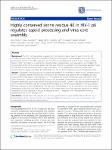Highly conserved serine residue 40 in HIV-1 p6 regulates capsid processing and virus core assembly
Votteler, Jörg
Neumann, Liane
Hahn, Sabine
Hahn, Friedrich
Rauch, Pia
Schmidt, Kerstin
Studtrucker, Nicole
Solbak, Sara MØ
Fossen, Torgils
Henklein, Peter
Ott, David E.
Holland, Gudrun
Bannert, Norbert
Schubert, Ulrich
Background: The HIV-1 p6 Gag protein regulates the final abscission step of nascent virions from the cell membrane by the action of two late assembly (L-) domains. Although p6 is located within one of the most polymorphic regions of the HIV-1 gag gene, the 52 amino acid peptide binds at least to two cellular budding factors (Tsg101 and ALIX), is a substrate for phosphorylation, ubiquitination, and sumoylation, and mediates the incorporation of the HIV-1 accessory protein Vpr into viral particles. As expected, known functional domains mostly overlap with several conserved residues in p6. In this study, we investigated the importance of the highly conserved serine residue at position 40, which until now has not been assigned to any known function of p6. Results: Consistently with previous data, we found that mutation of Ser-40 has no effect on ALIX mediated rescue of HIV-1 L-domain mutants. However, the only feasible S40F mutation that preserves the overlapping pol open reading frame (ORF) reduces virus replication in T-cell lines and in human lymphocyte tissue cultivated ex vivo. Most intriguingly, L-domain mediated virus release is not dependent on the integrity of Ser-40. However, the S40F mutation significantly reduces the specific infectivity of released virions. Further, it was observed that mutation of Ser-40 selectively interferes with the cleavage between capsid (CA) and the spacer peptide SP1 in Gag, without affecting cleavage of other Gag products. This deficiency in processing of CA, in consequence, led to an irregular morphology of the virus core and the formation of an electron dense extra core structure. Moreover, the defects induced by the S40F mutation in p6 can be rescued by the A1V mutation in SP1 that generally enhances processing of the CA-SP1 cleavage site. Conclusions: Overall, these data support a so far unrecognized function of p6 mediated by Ser-40 that occurs independently of the L-domain function, but selectively affects CA maturation and virus core formation, and consequently the infectivity of released virions.
Dateien zu dieser Publikation
Keine Lizenzangabe
Verwandte Publikationen
Anzeige der Publikationen mit ähnlichem Titel, Autor, Urheber und Thema.
-
2000-10-01ZeitschriftenartikelLebensmittelassoziierte Virusinfektionen Höhne, Marina; Schreier, EckartBis in die 70er Jahre war die Diagnostik von infektiösen Diarrhöen auf den Nachweis von Bakterien und Parasiten beschränkt, und auslösende Erreger konnten nur in einigen Fällen ermittelt werden. Verbesserte Nachweismethoden ...
-
2015-06-19ZeitschriftenartikelIn Silico Prediction and Experimental Confirmation of HA Residues Conferring Enhanced Human Receptor Specificity of H5N1 Influenza A Viruses Schmier, Sonja; Mostafa, Ahmed; Haarmann, Thomas; Bannert, Norbert; Ziebuhr, John; Veljkovic, Veljko; Dietrich, Ursula; Pleschka, StephanNewly emerging influenza A viruses (IAV) pose a major threat to human health by causing seasonal epidemics and/or pandemics, the latter often facilitated by the lack of pre-existing immunity in the general population. Early ...
-
2015-11-10ZeitschriftenartikelComparison of the Cowpox Virus and Vaccinia Virus Mature Virion Proteome: Analysis of the Species- and Strain-Specific Proteome Döllinger, Jörg; Schaade, Lars; Nitsche, AndreasCowpox virus (CPXV) causes most zoonotic orthopoxvirus (OPV) infections in Europe and Northern as well as Central Asia. The virus has the broadest host range of OPV and is transmitted to humans from rodents and other wild ...

